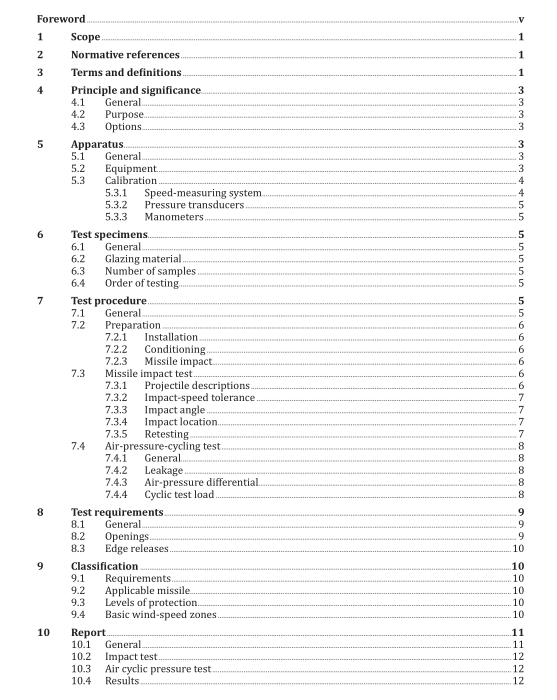ISO 16932:2020 pdf download.Glass in building — Destructive- windstorm-resistant security glazing — Test and classification
4 Principle and significance
4.1 General
This test method consists of mounting the test specimen and testing to an appropriate class, by impacting the test specimen with (a) missile(s) and then applying cyclic static-pressure differentials across the test specimen in accordance with a specified test-loading programme. The condition of the test specimen is observed and measured, and the results reported.
4.2 Purpose
The purpose of this document is to determine the resistance of various glazing materials and glazing systems to threats characteristic of destructive windstorms. Qualification under this document provides a basis for judgment of the ability of elements of the building envelope to remain without openings during a tropical cyclone.
This minimizes the damaging effects of a destructive windstorm on the building interior and reduces the magnitude of internal pressurization. Classification is intended as a basis for judging the ability of glazing to remain essentially without openings during a tropical cyclone with wind speed of 50 m/s or greater. Impact by missile(s) and subsequent cyclic static-pressure differentials simulate conditions representative of windborne debris and pressures in a destructive windstorm. Glazing is tested in a standard frame. Classification is based on the potential hazard to human life using the appropriate wind speed, pressure and level of protection.
4.3 Options
The user of this document either
a) tests the glazing material to a specified and required “level of protection” for classification according to 9.3, or
b) tests the glazing material to other conditions without classification as requested by the authority having jurisdiction, in which case the required information, as described in Annex A, shall be provided for the test procedure.
5 Apparatus
5.1 General Any equipment capable of performing the test procedure within the allowable tolerances may be used.
5.2 Equipment
5.2.1 Mounting frame supporting the outer specimen test frame(s) described in Annex B in a vertical position during testing. The maximum mounting-frame deflection of the longest member (either during impact or at the maximum specified static air-pressure differential) shall not exceed L/360, where L denotes the greatest unsupported length of a member of the mounting frame. Frame-deflection measurements shall be made normal to the plane of the specimen at the point of maximum deflection. The mounting frame shall be either integral with the test chamber or capable of being installed into the test chamber prior to or following missile impact(s). The mounting frame shall be anchored so it does not move when the specimen is impacted. The specifications for the inner and the outer specimen-support frame shall be as specified in Annex B.
5.2.2 Air-pressure cycling test chamber, consisting of an enclosure or box with an opening against which the test specimen is installed. It shall be capable of withstanding the specified cyclic static- pressure differential. The chamber shall be deep enough to avoid contact with the test specimen during pressure cycling. Pressure taps shall be provided to facilitate measurement of the cyclic static-pressure differential. They shall be located such that the measurements are unaffected by the air supplied to or evacuated from the test chamber or by any other air movements.
5.2.3 Air-pressure system, consisting of a controllable blower, a compressed-air supply/vacuum system or other suitable system capable of providing the required maximum air-pressure differential (inward and outward acting) across the test specimen. Specified pressure differentials across the test specimen shall be imposed and controlled through any system that subjects the test specimen to the prescribed test-loading programme. Examples of suitable control systems include manually operated valves, electrically operated valves or computer-controlled servo-operated valves.
5.2.4 Air-pressure-measuring apparatus.
Pressure differentials across the test specimen shall be measured by an air-pressure-measuring apparatus with an accuracy of ±2 % of its maximum rated capacity, or ±100 Pa, whichever is the lowest,and with a response time of less than 50 ms.ISO 16932 pdf download.ISO 16932 pdf download
